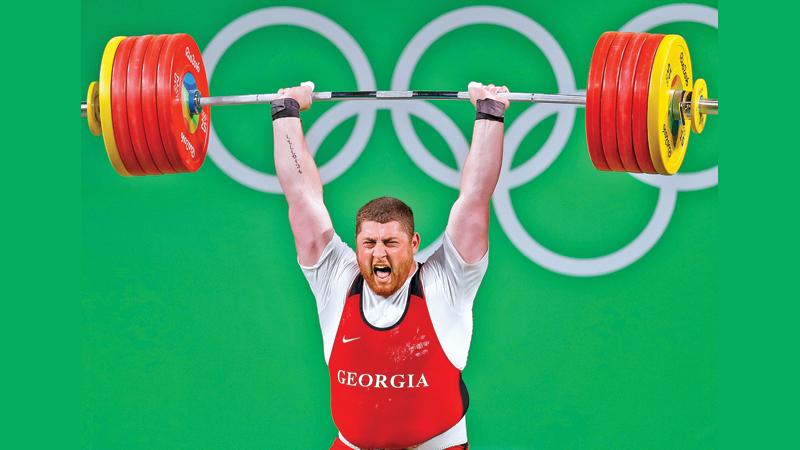
Weightlifting, which is one of the oldest sports known to mankind, was firmly rooted in Kandy with many of its exponents going on to represent Sri Lanka and win medals.
This is one of the prominent sports that could bring international fame to the country if it is well organized and supported. The sport in Kandy prospered largely due to the immense support and helping hand extended by the Kandy YMCA when they were housed around the Kandy Lake at that time and well backed by the National Olympic Committee and Sports Ministry.
Today there are sports like power lifting and strength exercises. But how prosperous are they? In the beginning there was the age of the professional strongman, performing on the vaudeville and music hall stages of Europe and America in the late 1800s. Professional events were flamboyant displays of strength and purposely non-standardized.
Every performer wanted to bill himself as “the Strongest Man in the World.” Some used trickery to get their edge.
Weightlifting at one time was dominated by Kandy and produced several weight lifters who brought honour to their clubs, themselves and the country. Kandy was the hub for the iron sport. All this was made possible due to the immense support and helping hand extended by Kandy YMCA, the National Olympic Committee and Sports Ministry, but today it is not so.
Test of strength had always been a challenge to young men throughout history and all civilizations have their legends associated with their feats of power. It is possible to suppose, that the lifting of weights, with wrestling and running were among man’s earliest means of measuring superiority.
Weightlifting was introduced to Sri Lanka as a sport in 1939 by an Englishman, who was a serviceman named GJP Hill at a trial contest at the Fort YMCA. This was followed by Kandy YMCA. In 1963, an organized and focused association was formed in the name of Sri Lanka Amateur Weight Lifting and Body Building Association. This association, like in 1939, conducted a trial meet for amateurs in 1963 which was continued until 1974. The same year, the bodybuilding section of the association broke away and formed the Sri Lanka Amateur Body Building Association which was since 1977 called the Sri Lanka Weight Lifting Federation.
The Sri Lanka Weigh Lifting Federation is a member of all its senior federations like the Asian, Commonwealth and the International Body Building Federations. Since the Federation was formed, it expanded its activities to the four corners of the country with the help of the NOC and Ministry of Sports.
On a hopeful note, weightlifting is catching up in some schools. Even girls are interested in taking to this sport.
Sri Lankan weightlifters have taken part in overseas meets from the 1982 Asian Games and in the 1984 Olympics in addition to several international championships. In 1986 one of the lifters at the Commonwealth Championships in Malta won a bronze medal.
In the good old days, promoters such as SA Wijewickrema (senior and junior), A Dharmadasa, Mauirce Windus, Niyas Majeed, Mahes Sabaratnam and others did their best to promote this sport. When the sport was declining and on the verge of heading towards a natural death, the above mentioned people came forward and brought the sport to its original status with great commitment and dedication.
There is another person in weightlifting that one cannot forget. He is TSJ Pakeerali the doyen of iron sport. When the iron sport was revived after 40 odd years, the first team to tour overseas, was made up of GVA de Croos (Bantam Weight– Univesity of Peradeniya), SA Wijewickrema Jnr. (Feather Weight -YMCA), Mahesh Sabaratnam (Light Weight YMCA and Kandy Lake Club), Niyaz Majeed (Middle Weight - YMCA and Kandy Lake Club), WSK Perera (Light Weight- Royal Ceylon Air Force,).
The team was managed by J. Ranasinghe, TSJ Pakeerali (Coach) who was a FIFA qualified football coach and Linne Schoorman who went as referee. This was to Peking in 1966. Then later a lifter like Athula Wijewickrema, SM Faizal, Asela Wijewickema, HC Perera, DUM Jayatilleke, Gamini Kumarasinghe, PURSB Weragama, RAS Ransinghe and MC Alwis held sway.
When Baron Pierre de Coubertin revived the ancient Olympics in 1906, Weightlifting was one of the six games in the Olympics. The essential difference between weightlifting and weight training is that the former is a standardized sport practiced widely, requiring skill as well as great strength. Weight training is a basic form of exercise that is needed by anyone, athlete or non athlete like rugby players who want to develop strength and superior physical fitness.
